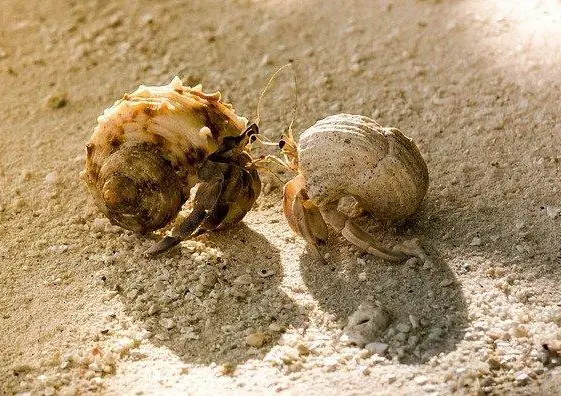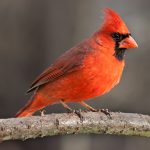They share more genetic similarities with certain species of lobsters than they do with true crabs. Hermit crabs have a tail that is curled into a hook, which allows their bodies to fit inside the shells that they borrow from other animals. When a new shell is discovered, hermit crabs will often form a line, going from largest to smallest, in order to determine which animal is the best fit for the shell.
Hermit crabs are anomuran decapod crustaceans that belong to the Paguroidea superfamily. Over the course of evolution, they have developed the ability to protect their delicate exoskeletons by filling empty snail shells that they have scavenged. Long-armed hermit crabs are the kind of sea crabs that may be found on the shorelines and rocky or sandy bottoms of Barnegat Bay.
They make their home in the grass beds that extend from the line where the low tide begins to the deeper bay waters. Hermit crabs that live on land have gills that have been modified to be more rigid so they can breathe oxygen. Individual hermit crabs appear to prefer to hibernate for an extended period once they have completed the molting process.

There are seven separate groupings, each containing its own unique species, to which these ones belong. Hermit crabs go through periods of protracted behavior that are referred to as molting, and during these times, they may become inactive. A prolonged hibernation can cause irreversible harm to your animal companion.
There are around 800 different species of hermit crabs, the majority of which have an asymmetric belly that is covered by a body that fits closely. As is the case with fish, snails, and blue crabs, hermit crabs may frequently employ their shells as an additional layer of defense against a broad range of predators.

Why is my hermit crab not moving?
The temperature and humidity of the tank are not only necessary for the hermit crab to be alive but also help it to fly. Your hermit crab runs the risk of dying from the water in its surroundings or perhaps from the deadly paint that you’ve applied to its shell if it doesn’t move around too much. In addition, lethargy might be a sign of strain in the body.

Be aware that the majority of hermit crabs like playing and may do so quite a bit even when they are not molting or are not ill. Hermit crabs can also travel around their habitats quite a bit. Check to see if the hermit crab is moving about all the time and not dangling out of its shell since this might be a sign that it has passed away. Take note that the molting process is frequently characterized by a lack of mobility.
How long do Hermit Crabs hibernate?
Hibernation for an extended period of time might cause permanent damage to the hermit crab. The obvious truth is that the exoskeleton provides protection for the crab as well as camouflage for it. After a period ranging from one to two months spent hibernating deep under the sand, the crab will begin the process of forming a new exoskeleton.
It is assumed that females have long hair so that they can conceal their eggs and chicks when they fly. The blue crab is able to survive the winter by going into hibernation in deeper water, where it digs tunnels into the muddy or sandy bottom, as the temperature of the water begins to drop and the days become shorter on average. If none of the previous treatments have helped, or if you are not feeling calm, you should consider going to the clinic to see the hermit crab.

How long will my hermit crab stay buried?
When it comes to the whole procedure, the rule of thumb is that the larger the crab, the longer it will take. It is not unheard of for a crab of average size to take anywhere from four to eight weeks to finish the entire process, during which time it may remain totally buried in the sand.

How cold is too cold for hermit crabs?
Hermit crabs are best housed around 72 to 80 degrees Fahrenheit (22 to 27 degrees Celsius). The crabs are likely to grow sick, anxious, and feeble if the temperature remains consistently below 72 degrees Fahrenheit for an extended period of time.
Is my hermit crab dead or hibernating?
Hermits are nocturnal animals, so it’s possible that you won’t observe any activity from them throughout the day. Check for any tracks or other evidence of movement, but do not attempt to move your crab just yet, even if you have a strong suspicion that they have already passed away. The appearance of mound is the one and only sure-fire technique to determine whether or not your crab has passed away.
How do hermit crabs survive the winter months?
When temperatures drop, wild hermit crabs are said to burrow deeper and deeper into the substrate in order to protect themselves from the elements. Your hermit crabs will attempt to mimic your behavior. Hermit crabs will have increased protection from the brisk air the deeper down the substrate they are able to burrow.
What does a molting hermit crab look like?
They will eventually lose their entire outer shell, at which point they will shed it and replace it with new skin that will eventually harden into a shell. The exoskeletons of these animals are typically discovered close to the molting crab. It has the appearance of a dead crab, but upon closer inspection, you can see that it is hollow. You shouldn’t get rid of it because they’ll eat it when they’re done.

Can Hermit Crabs suffocate when buried in sand?
They will drown if they try to breathe underwater. Land hermit crabs will suffocate and perish if they do not receive adequate amounts of water and moisture. Make sure the air in the tank is breathable before you put your hermit crabs in there. This is a requirement before you put them in there.
What Happens When Hermit Crabs Poop?
The anus, which is located at the very tip of a hermit crab’s tail, is where these crabs deposit their waste. If you’ve ever observed a hermit crab, you know that its tail is typically concealed quite well within its shell. As a result of the fact that this is where their anus is located, their waste is retained within their shells as they live out their lives as crabs.

Can you combine two hermit crabs?
Hermit crabs flourish in the warm, humid climate of the tropics. Hermit crabs are really gregarious organisms that may coexist with other hermit crabs in groups or couples despite their common moniker. Pick a terrarium that has at least 5 gallons of room for each pair of crabs you intend to keep. It is important that the terrarium have a hood so that the humidity can be maintained and your hermit crab cannot escape.

At what temperature do hermit crabs die?
Hermit crabs are susceptible to hypothermia and can perish when the water in their tank dips below 50 degrees Fahrenheit; however, this is often not a problem for most aquariums. Having said that, they do not react well when exposed to frigid temperatures. The long-term effects of keeping crabs in tanks at temperatures lower than below 70 degrees Fahrenheit can be detrimental to their health.
When do hermit crabs change their shells?
Most crabs will molt at least once every 18 months if they are healthy. Crabs that are smaller don’t always molt more often, but sometimes they do. So, don’t worry if your crab hasn’t shed its old skin after a year. Just keep taking good care of it, and when it’s time, the crab will molt.

Do crabs that live in shells need light at night?
Hermit crabs are nocturnal, which means they are most active in the evening and overnight. However, its enclosure has to be completely black throughout the night, just like it would be in the wild. You won’t need to use an additional source of lighting for the tank at night if the room is already well-lit during the day.
Do Hermit Crabs Yell When They Poop? And Other FAQs about Polar Bears
Do hermit crabs yell when they poop? While hermit crabs don’t make any noticeable sounds when they eliminate waste, their unique behavior has made people curious. On a related note, polar bears’ bowel habits and other frequently asked questions are also intriguing. From their diet and hunting patterns to their habitat and conservation status, there is much to explore about these magnificent creatures.
What is the lifespan of a hermit crab?
Hermit crabs are excellent pets and are surprisingly simple to take care of. The hermit crab is able to adapt to terrestrial life by using empty shells as both a shelter and a means of self-defense. This ability has allowed the hermit crab to develop. Your hermit crab has the potential to live up to around 15 years if it is well taken care of.









